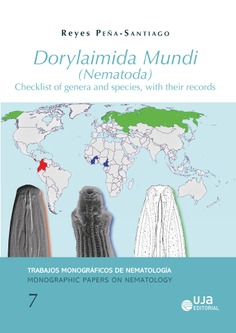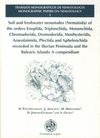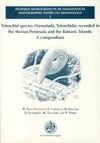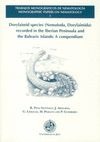
Cómo citar este libro
Reyes Peña, Santiago. (2021). Dorylaimida Mundi (Nematoda). Universidad de Jaén. UJA Editorial.
Comprar en librerías
Dorylaimida Mundi (Nematoda)
Checklist of genera and species, with their records
Reyes Peña Santiago
Dorylaims, the members of the order Dorylaimida, probably are the most diverse ordinal taxon within the phylum Nematoda. Because of their worldwide distribution in continental habitats and their variety of life strategies, they are regarded as good bioindicators of environmental health. This book provides a compendium of available information about dorylaimid taxa and their geographical records. Based on the scrutiny of a total of 3385 documents, mainly journal papers, but also books and monographs, it includes 3453 nominal species (3088 valid, 244 synonymous and 121 inquirendae or incertae sedis) and 363 nominal genera (285 valid, 75 synonymous, 3 inquirenda), which were described until the end of 2020. The book consists of four recognizable sections. Most content focuses on updating the catalogue of taxa, together with the references recording each of them. Besides, geographical (country, archipelago, etc.) and environmental (habitat) data about every species are also given. The second part presents the references mentioned in the main body of the work. The third section offers an alphabetical list of generic and subgeneric names, whereas the fourth one gives an alphabetical list of species names. The book is addressed especially, but not only, to young researchers, who very often face serious difficulties to find suitable bibliographic references to confirm species identification or simply to access previous records of a particular taxon in a definite territory. Thus, it aims to assist and to guide any nematologist interested in the exploration of dorylaimid diversity and its geographical distribution.
________________________________
Los doriláimidos, componentes del orden Dorylaimida, son probablemente el grupo ordinal más diverso dentro del filo Nematoda. Debido a su distribución mundial en hábitats continentales y a la variedad de estrategias vitales que presentan, son considerados buenos bioindicadores de calidad ambiental. Este libro presenta un compendio de la información disponible sobre los taxones doriláimidos y sus citas geográficas. A partir del escrutinio de un total de 3385 documentos, principalmente artículos de revistas, pero también libros y monografías, incluye 3453 especies nominales (3088 válidas, 244 sinónimas y 121 inquirendae o incertae sedis) y 363 géneros nominales (285 válidos, 75 sinónimos, 3 inquirenda) que habían sido descritos hasta finales de 2020. El libro se compone de cuatro apartados básicos. La mayor parte de su contenido se dedica a actualizar el inventario de los taxones doriláimidos, junto con las referencias que han tratado cada uno de ellos. Además, se aporta información geográfica (país, archipiélago, etc.) y ambiental (hábitat) sobre cada especie. La segunda sección presenta las referencias mencionadas en el cuerpo principal del texto. Una lista alfabética de los géneros y subgéneros se provee en la tercera parte, en tanto que la cuarta ofrece la lista alfabética de especies. Esta obra va dirigida especialmente, pero no solo, a investigadores jóvenes, que con frecuencia experimentan serias dificultades a la hora de encontrar bibliografía adecuada para confirmar la identificación de las especies que encuentran o simplemente para acceder a las citas previas de un taxón particular en un territorio determinado. Por tanto, persigue ayudar y dirigir a cualquier nematólogo interesado en el estudio de la diversidad de doriláimidos y de su distribución.
- Autor/a
- Reyes Peña Santiago
- Colección
- Ciencias Experimentales y de la Salud. Serie Avances Recientes
- Materia
- Zoología y ciencias animales
- Idioma
- Castellano
- Editorial
- UJA Editorial
- EAN
- 9788491594567
- ISBN
- 978-84-9159-456-7
- Páginas
- 962
- Ancho
- 17 cm
- Alto
- 24 cm
- Edición
- 1
- Fecha publicación
- 30-12-2021
- Número en la colección
- 7
Sobre Reyes Peña Santiago (Autor/a)
Reseñas
The dorylaims form one of the most important nematode groups in the soil, being highly speciose with more than 3400 nominal species (3088 are regarded as valid in the current work) and 363 nominal genera, 285 being regarded as valid. Dorylaims display high diversity in their morphology, behaviour and ecology and are found in abundance in most soils around the world. As such, members of the group have particular potential as biological/environmental indicators in soil ecology studies. Being such a large and diverse group, the literature is often difficult to locate and access, this volume being designed to address that problem within the confines of its covers.
As might be expected, given the stated intention, this is a large tome weighing in at around 960 pages. It provides a compendium of the available information (to the end of 2020) on dorylaim taxa together with their references. The book is divided into four sections: i) List of genera and species, with their records — comprising a catalogue of the currently recognised taxa with their synonyms and reference citations; ii) References; iii) List of genera — an alphabetical list of taxa at the generic and subgeneric levels, together with their synonyms; and iv) List of species — an alphabetical list of valid species names and their synonyms. As one would expect, the first section, at 664 pages, forms the majority of the 957 pages of the book; the references take up the next 172 pages, and the taxa indexes the remainder with the List of genera occupying ten pages and the List of species some 108 pages. Valid taxa are clearly indicated in bold font.
The layout of the book is very clear and unambiguous. In the first section, for example, each genus heading is centred with its authority and taxonomic citations listed underneath as author, date and source (but, to save space, no title) together with indications in square brackets as to the scope of the reference, such as ‘Taxonomy’, ‘Compendium’, etc. The list of valid species then follows, the left-margined epithets in bold font followed by the complete authority. Junior synonyms, when appropriate, are listed below each name and fully sourced as per the genus heading. The Principle of Coordination is followed. An asterisk before a reference indicates that no taxonomic/morphological information but only distribution data are cited, whereas a question mark indicates that the recorded identity of the taxon in the reference may not be correct.
As to production, the book is hard bound and printed on a nice quality paper. To my (old) eyes the font is rather small and perhaps a trifle ‘spidery’ in appearance; for some reason the letter ‘t’ does not extend above the other letters in the Roman-style font text (letters such as ‘f’, ‘b’, ‘d’, and ‘l’ do…), although it does so in the even smaller, but rather pleasing, italic font. Use of larger fonts throughout would probably have necessitated a two-volume approach, so I can well understand the production decision — the book is designed for information retrieval, not bedtime reading. Even so, this is one book where an electronic version would be a very definite advantage.
So, does the author succeed in his aim? Yes, indeed he does. The text should prove to be of inestimable value to both the dorylaim researcher and others interested in this group, and represents a distillation of a lifetime’s study and profound knowledge of this large and important group of soil animals. Reyes Peña-Santiago is to be congratulated for his care and attention in compiling such a taxonomic lexicon of the Dorylaimida.
The dorylaims form one of the most important nematode groups in the soil, being highly speciose with more than 3400 nominal species (3088 are regarded as valid in the current work) and 363 nominal genera, 285 being regarded as valid. Dorylaims display high diversity in their morphology, behaviour and ecology and are found in abundance in most soils around the world. As such, members of the group have particular potential as biological/environmental indicators in soil ecology studies. Being such a large and diverse group, the literature is often difficult to locate and access, this volume being designed to address that problem within the confines of its covers.
As might be expected, given the stated intention, this is a large tome weighing in at around 960 pages (Fig. 42). It provides a compendium of the available information (to the end of 2020) on dorylaim taxa together with their references. The book is divided into four sections: i) List of genera and species, with their records – comprising a catalogue of the currently recognised taxa with their synonyms and reference citations; ii) References; iii) List of genera – an alphabetical list of taxa at the generic and subgeneric levels, together with their synonyms; and iv) List of species – an alphabetical list of valid species names and their synonyms. As one would expect, the first section, at 664 pages, forms the majority of the 957 pages of the book; the References take up the next 172 pages, and the taxa indexes the remainder with the List of genera occupying ten pages and the List of species, some 108 pages. Valid taxa are clearly indicated in bold font.
The layout of the book is very clear and unambiguous. In the first section, for example, each genus heading is centred with its authority and taxonomic citations listed underneath as author, date and source (but, to save space, no title) together with indications in square brackets as to the scope of the reference, such as ‘Taxonomy’, ‘Compendium’, etc. The list of valid species then follows, the left-margined epithets in bold font followed by the complete authority. Junior synonyms, when appropriate, are listed below each name and fully sourced as per the genus heading. The Principle of Coordination is followed. An asterisk before a reference indicates that no taxonomic/morphological information but only distribution data are cited, whereas a question mark indicates that the recorded identity of the taxon in the reference may not be correct.
As to production, the book is hard bound and printed on a nice quality paper. To my (old) eyes the font is rather small and perhaps a trifle ‘spidery’ in appearance; for some reason the letter ‘t’ does not extend above the other letters in the Roman-style font text (letters such as ‘f’, ‘b’, ‘d’, and ‘l’ do…), although it does so in the even smaller, but rather pleasing, italic font. Use of larger fonts throughout would probably have necessitated a 2-volume approach, so I can well understand the production decision – the book is designed for information retrieval, not bedtime reading. Even so, this is one book where an electronic version would be a very definite advantage.
So, does the author succeed in his aim? Yes, indeed he does. The text should prove to be of inestimable value to both the dorylaim researcher and others interested in this group and represents a distillation of a lifetime’s study and profound knowledge of this large and important group of soil animals. Reyes Peña-Santiago is to be congratulated for his care and attention in compiling such a taxonomic lexicon of the Dorylaimida.
Libros relacionados

The genus Crassolabium Yeates, 1967 (Nematoda, Dorylaimida): A monographic study

Soil and freshwater nematodes (Nematoda) from Romania: A compendium

Soil and freshwater nematodes (Nematoda) of the orders Enoplida, Triplonchida, M

Tylenchid species (Nematoda, Tylenchida) recorded in the Iberian Peninsula and the Balearic Islands:

Dorylaimid species (Nematoda, Dorylaimida) recorded in the Iberian Peninsula and the Balearic Island


 Unebook
Unebook  Todos tus libros
Todos tus libros  Casa del libro
Casa del libro 
